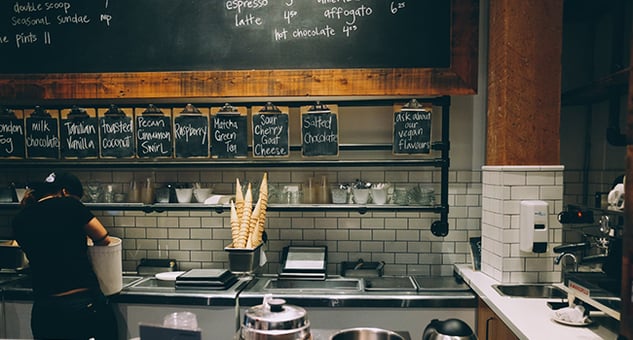Most venues are designed with the customer in mind; we consider the look, and the feel, the color palate, and the theme of a restaurant and the ‘experience’ we want our customers to have.
But do we consider the staff or what it takes for a restaurant to be efficient, and therefore be profitable? A restaurant’s design involves more than just an aesthetic outcome, it needs an operational one as well.

Unless you charge admission, the profitability of your restaurant depends not just upon its ‘look and feel’, but on how quickly, and accurately, menu items can be produced, and how effectively your staff can deliver unique customer experiences.
It depends on productivity; the number of transactions it can complete per hour, and the value of those transactions.
So how do we design our restaurants for profitability? Here are some tips to consider to ensure your restaurant or hospitality venue is making money.
Analyze and increase your productivity levels
The more money a restaurant makes in relation to the money it's spent on staffing, the more productive it is. The more productive, the more opportunity it has for profit.
Productivity is a long-term measure; you can cut staffing on a single shift, and increase it’s productivity, but risk reducing customer satisfaction, that will over time lead to reduced profitability.
The factors that determine the productivity of your restaurant involve both the physical design of the restaurant; the layouts of the production area (where we produce and/ or store food and beverages), the service area where we serve our guests, and the operational decisions that comprise a restaurant - i.e. the style of service, the menu item positioning and the pricing strategy.
Case study: Taco Bell
In the ‘90’s Taco Bell undertook a research project to optimize their stores. A key discovery of the project was that a customer would wait in line for no longer than three minutes before they left the store and purchased somewhere else.
With over 50 percent of Taco Bell’s daily sales occurring between 11am and 2pm; the three hours over lunch, Taco Bell focused not on adding more pressure to their staff to work harder, but on restructuring the business to become more efficient and cost-effective.
Taco Bell completely remodelled their stores, adapted the Point of Sale and technology systems and re-trained their staff and they achieved their ‘three-minute window’.
What was the effect?
The total labor saving achieved by Taco Bell over the four-year period, 1993–1996, was over $40 million. It’s new found efficiency propelled it’s `value pricing ‘strategy and it became the world's fourth largest restaurant chain by the turn of the century.
Why? It’s because they understood their productivity levels and in turn knew what was required to achieve their profit target.
Know the value of time
It’s important as a restaurant owner to understand that time is valuable for the business, the staff and for the customers.
For staff
How you serve and treat your customers will determine what your customer will spend, if your customers will return and ultimately define your potential for profitability.
But how well your staff can do that is determined by the venue and service design.
The number of staff your business can afford to have on per shift determines the level of customer service your business can afford to give, and the amount of time your staff has available to do all the tasks that make up a successful and memorable occasion for your guests.
Time determines the minimum number of staff you must have in quiet periods to serve guests; your minimal operational staffing level, regardless of whether you can make money on those shifts or not, and where you can adopt an expense reduction or revenue enhancement mindset over your busiest periods.
For customers
The basic level of customer service expected in any restaurant requires staff to effectively and efficiently produce menu items, to anticipate the needs of guests, to sense when a customer is ready to order, if their drink needs to be refilled, when the bill should be brought out; and, all in a timely fashion.
Remember customers don’t want to waste unreasonable time waiting, to be served, for the meal to arrive, for their drink to be refilled; but rather spend time enjoying their dishes and their company. Their experience therefore is heavily influenced on time, think back to the Taco Bell example.
It is these elements of service that are helped or hindered by the choices that are made in the physical and operational design of the restaurant.
These choices determine the experience your guests will have by defining in advance the experiences your staff can deliver in the time they have available. These choices can determine if you’ll lose customers or gain loyal ones and when taken all together, whether you can be profitable or not.

Get your service area layout right
If a drink priced at $5 takes 5 minutes to make, that employee can only make 12 drinks an hour; that’s $60 revenue per one hour of labor. If through design, physical design, service and menu design, that drink takes 3 minutes to make, you have increased revenue to $100 per hour of that employee’s time.
What goes into either limiting or unlocking that productivity measure are the features of your design.
The capital expense of a functionally designed service area, kitchen and bar, is much cheaper than the operational expense of higher ongoing labor costs, or a lower rate of production due to insufficient staff or poorly considered spaces for your staff to do their jobs well.
An extra $10,000 spent in the kitchen that saves you $500 a week in operational costs and increases the number of menu items you can sell in the peak trade windows, can be the very difference between the survival or failure of your restaurant.
Restaurants enjoy short periods of intense trade, and long periods of slow trade; as few as 12 hours over your busiest periods can account for 50 percent of your weekly revenue.
It is this weekly seasonality, when combined with an annual seasonality, that makes the restaurant industry one of the most complex in the world.
However with the right design of your service area, some of this can change.
Calculate your operational costs
There are few hard and fast rules in restaurants operations; your cost of goods (COGs) can be higher, because your pricing strategy focuses on maximising your number of sales per hour, but your labor must be lower.
Or your labor can be higher, as with table service, or fine-dining, but the COGs needs to be lower, and your average check higher.
What is key is that your whole of business is orientated towards the model that maximizes your profitability, customer service, and suits your individual business.
A low price, high COGs, high number of sales per hour model doesn’t work with a table service model that maximises the length of stay and increases your labor cost for example – one requires a shorter guest stay, the other a longer one.
So where do we start?
Some key questions to consider, both from a new restaurant not yet opened, but also an existing restaurant’s perspective;
- What are your occupancy costs?
- What are your overheads? (These are your expenses excluding your occupancy costs, labor and COGs).
- What is your profit target? How much money does your business need to achieve?
- What is your target Cost of Goods? (This is a key element that is determined by your menu design, pricing and inventory turnover, and your table-turn strategies)
- What are your target labor costs? This is a key element determined by everything that precedes it and defines the choice of style of service.
Here it might help to get some professional advice from a consultant or accountant (or both) to sort through the numbers.
These are the key bits of information that set the context for your restaurants design. But what do we do with them? Once you know these details it will help set the design parameters to determine the service workflow, and the equipment needs of the kitchen, bar and guest seating areas, not only in its peak times, but as importantly, the quiet times.
You’ll also be able to identify how many hours you must spend on staffing each week, the intricacies of what the menu needs to be, how many meals and drinks you will need to produce in those peak 12 hours to be profitable.
This then becomes your profit architecture, and will inform every decision that needs to be made. You now have a blue print for profitability.
Learn more about food cost management and start our course now with Ryan Gromfin.
 |
Ivan Brewer is the founder of ivanbrewer.com.au, an Australian restaurant/ cafe and bar consultancy based in Queensland. He's been on the front line of every type of hospitality business imaginable for over 20 years, and has led thousands of staff and made profitable dozens of food businesses through unique strategies.
|
You might also like